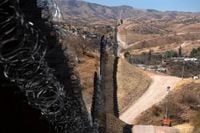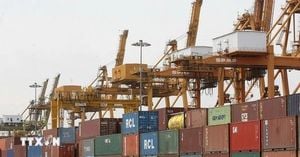President Donald Trump’s second term has been marked by a rapid escalation of economic and military pressure on Latin America, a region that has long been at the crossroads of U.S. foreign policy. On August 5, 2025, Trump signed an executive order related to the 2028 Los Angeles Olympic Games, but it was his threat of a sweeping 50 percent tariff on all Brazilian imports that truly sent shockwaves through diplomatic and economic circles. The move was particularly surprising given that the United States has enjoyed a trade surplus with Brazil since 2007, according to Morning Star.
Brazilian President Luiz Inácio Lula da Silva wasted no time in responding, promising reciprocal tariffs and making it clear that Brazil would not be cowed by U.S. threats. "The defense of democracy in Brazil is a matter for Brazilians," Lula declared, adding, "We do not accept interference or tutelage from anyone. We have solid and independent institutions. No one is above the law. Especially those who attack freedom and the rule of law." Lula’s words, reported by Morning Star, underscored a growing resistance in Latin America to what many see as U.S. overreach.
Trump’s aggressive tariff policy goes well beyond Brazil. In January 2025, he threatened Colombia with sanctions and 25 percent tariffs on all exports to the U.S. The threat escalated: if Colombia did not comply with U.S. demands, tariffs could rise to 50 percent, with exhaustive inspections and visa sanctions imposed on Colombian officials. Colombia’s President Gustavo Petro responded in kind, announcing 50 percent tariffs on U.S. goods and criticizing the U.S. approach to Latin America, especially Washington’s stance on the war in Gaza and NATO alliances.
Mexico, too, has found itself in the crosshairs. The U.S. has had a trade deficit with Mexico since 1995, following the North American Free Trade Agreement (NAFTA). Trump has accused Mexico of being a drug-trafficking hub, but President Claudia Sheinbaum has pushed back, pointing out that the U.S. is the world’s largest narcotics consumer and the main exporter of weapons used by drug cartels. She has also refused U.S. troop deployments on Mexican soil, defending her country’s sovereignty at every turn.
Meanwhile, Trump’s administration has ramped up military involvement in the region. Since returning to the White House in 2025, Trump has directed the U.S. military to target Latin American drug cartels, which he blames for the flow of fentanyl and other illicit drugs into the U.S., according to CBS News. An executive order signed at the start of his second term instructed the State Department to designate cartels and transnational gangs as foreign terrorist organizations. In February 2025, eight gangs—including MS-13 and Tren de Aragua—received this designation. The Treasury Department also sanctioned Venezuela’s Cartel de los Soles, led by President Nicolás Maduro, as a Specially Designated Global Terrorist group in July 2025.
The U.S. government has gone so far as to offer a $50 million reward for information leading to Maduro’s arrest. Venezuelan Foreign Minister Yvan Gil dismissed the move as "pathetic" and "crude political propaganda," as reported by CBS News. Secretary of State Marco Rubio explained the rationale for the terrorism designation, saying, "It’s no longer a law enforcement issue. It becomes a national security issue." Rubio added, "The designation allows us to now target what they're operating and to use other elements of American power—intelligence agencies, the Department of Defense, whatever—to target these groups if we have an opportunity to do it."
Trump’s administration has also deployed over 10,000 military service members to the U.S.-Mexico border to support immigration enforcement, with the Pentagon establishing three National Defense Areas in Arizona, New Mexico, and Texas. These areas, treated as extensions of military bases, are intended to enhance border security, according to U.S. Northern Command. In June 2025, Trump ordered roughly 4,000 members of California’s National Guard to Los Angeles—over the objections of Governor Gavin Newsom—to assist with immigration enforcement, supported by about 700 active-duty Marines.
But the Trump administration’s hardline approach is not limited to military deployments and tariffs. The government has terminated Temporary Protection Status (TPS) for hundreds of thousands of Nicaraguans, Cubans, and Venezuelans, a move that has upended lives and drawn criticism from human rights advocates. Many migrants have been sent to a detention center in El Salvador, run in cooperation with President Nayib Bukele, a staunch U.S. ally.
These moves are part of a broader U.S. strategy to counter China’s growing influence in Latin America and the Caribbean. China is now the main trading partner for South America and the second-largest for Central America. The U.S. Southern Command has acknowledged that China’s trade with the region has expanded beyond raw materials to include infrastructure projects, electric vehicles, telecommunications, and renewable energy. Notably, China built the port of Chancay in Peru—a major Belt and Road initiative—and Honduras has switched diplomatic recognition from Taiwan to Beijing. Colombia has joined the BRICS alliance, and Brazil, under Lula, has strengthened ties with China.
Trump has threatened all BRICS countries with 100 percent tariffs, signaling a willingness to escalate the economic confrontation. The U.S. success in Panama, where President Jose Mulino agreed to exit China’s Belt and Road Initiative after Trump threatened military action to retake the Panama Canal, stands as a rare victory for Washington’s pressure campaign.
Domestically, the Trump administration’s hardline stance has found both support and criticism. Some lawmakers have used the foreign terrorist designation to disrupt cartels’ financial networks and impose harsher penalties on those who support them. Federal prosecutors in May 2025 accused a Mexican cartel member of providing grenades to a designated terrorist organization, a case that highlighted the expanded legal authority granted by the new designations.
Yet, critics argue that Trump’s approach risks destabilizing fragile economies and undermining regional cooperation. The termination of TPS and the militarization of the border have sparked protests and drawn accusations of human rights abuses. Latin American leaders have pushed back, emphasizing their sovereignty and rejecting what they see as U.S. interference in their domestic affairs.
Amid these tensions, the U.S. continues to expand its military footprint in the region. Ecuador’s President Daniel Noboa amended the constitution to allow U.S. military bases on the Galapagos Islands. The U.S. holds regular joint military exercises in Guyana and maintains bases throughout Central America, Colombia, the Caribbean, Peru, and now Argentina.
Ultimately, Trump’s tariffs and military maneuvers are aimed at slowing Latin America’s shift toward a multipolar world—one in which China, the BRICS, and other emerging powers play a larger role. The U.S. sees this as an existential threat to its traditional dominance, while many Latin American nations view closer ties with China as a path to greater independence and development.
As the summer of 2025 unfolds, the battle for influence in Latin America is heating up, and the region’s leaders are making it clear that they intend to chart their own course—no matter how high the tariffs or how loud the threats from Washington.




